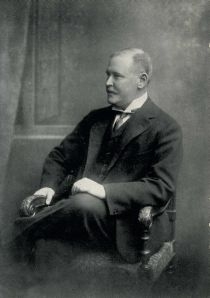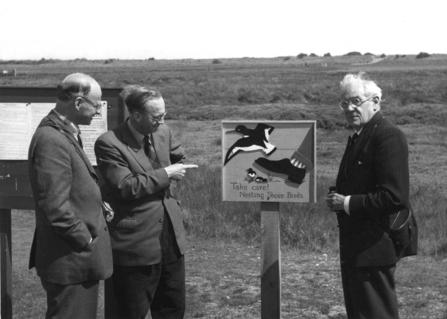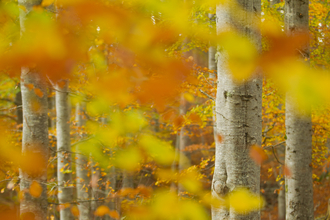
Our history
How it all began
In May 1912, a month after the Titanic sank, banker and expert naturalist Charles Rothschild held a meeting at the Natural History Museum in London to discuss his idea for a new organisation to save the best places for wildlife in the British Isles. This meeting led to the formation of the Society for the Promotion of Nature Reserves. Rothschild's vision was to identify and secure protection for our islands' most important wildlife sites. His vision was a radical one that led to nature conservation as we know it.
Watch a film about our history
Charles Rothschild

Nathaniel Charles Rothschild (1877-1923) was part of his family's banking empire, and a good banker by all accounts. But his real passion was wildlife, not least insects, and he was deeply concerned by the loss of his beloved fens. The organisation he founded in 1912 was the beginning of The Wildlife Trusts. A man before his time, he called for protection of whole habitats as well as individual species and knew conservation policy had to be based on sound science.
Rothschild's daughter, Miriam, who was also a gifted scientist later played a key role with the Society too. Sadly, Rothschild died in 1923 and so never saw the 1949 Act of Parliament that was the culmination of his work and vision. Nevertheless his legacy lives on today in the form of a powerful movement of Wildlife Trusts covering the length and breadth of the United Kingdom.
A list of Britain's most important places for wildlife
The initial aim of Rothschild's society was to create a list of Britain's finest wildlife sites so they could be protected for the future. Three years of information gathering followed - the first ever national survey of wildlife sites - in England, Scotland, Wales and Ireland. Rothschild and his friends (including Neville Chamberlain who went on to become Prime Minister) were looking for the 'breeding-places of scarce creatures', the 'localities of scarce plants' and areas of 'geological interest'.
The original list included now classic nature reserves and well-known wildlife hotspots
By 1915 they had compiled a list of 284 sites 'worthy of preservation' - the Rothschild Reserves.
While some have been devastated by development, or simply vanished in the mists of time, those that survive are now all SSSIs and/or designated nature reserves, many of them protected by law. The original list included now classic nature reserves and well-known wildlife hotspots.
Learn more about Rothschild's List over the years, see the full list, and browse archive photos and documents:
Following Rothschild's death in 1923, the Society tried to secure Government protection for sites across the UK they considered ‘worthy of preservation’, but it was not until the 1940s that nature conservation made it into law with the creation of the National Parks & Access to the Countryside Act in 1949. Finally Rothschild's original vision of protecting Britain's most important places for wildlife was coming to pass. This set up the first Government's conservation agency (the Nature Conservancy Council), and the first National Parks and protected wildlife sites (Sites of Special Scientific Interest - SSSIs).
In pictures
The formation of local Wildlife Trusts
Meanwhile local conservation organisations, the forerunners to Wildlife Trusts, were beginning to spring up. The first was Norfolk in 1926, followed by Yorkshire in 1946 and Lincolnshire in 1948. The 1950s saw more and more groups beginning to form and by the end of the decade, the Society that Rothschild had formed took on the role of a national association to represent them.

Max Nicholson, Ted Smith & Lord Hurcomb at Gibraltar Point in 1960
Ted Smith, a founder of the Lincolnshire Wildlife Trust, played a key role in nationally coordinating the emerging Trusts. The Scottish Wildlife Trust was formed in 1964 and, with this, Wildlife Trusts now covered the whole of Britain. The movement expanded further in 1978 with the formation of the Ulster Wildlife Trust. There are now 46 Wildlife Trusts covering the whole of the UK, the Isle of Man and Alderney, supported by a central charity - The Wildlife Trusts - which is the same organisation that Rothschild founded more than a century ago.
A Timeline of The Wildlife Trusts: 1912 - today
1912
SPNR is established by Rothschild at a meeting in London on 16 May
1915
The SPNR compiles a list of 284 sites they consider ‘worthy of preservation’ across England, Scotland, Wales and Ireland and sets about trying to save what it can.
1919:
The SPNR acquires its first nature reserve – Woodwalton Fen in Cambridgeshire, gifted to them by Charles Rothschild.
1926:
The Norfolk Naturalists’ Trust is formed, and acquires Cley Marshes as its first reserve.
1937:
Herbert Smith, a gemologist at the Natural History Museum, takes over as the General Secretary of the Society.
1941:
The Government begin to think about post-war construction and the SPNR chair and finance a hugely influential Conference on Nature Preservation in Post-War Reconstruction – which ultimately influenced the process of setting up statutory nature reserves.
1942:
The Government's Nature Reserves Investigation Committee is formed. This is the vehicle through which the SPNR can begin to see Rothschild's original vision realised, as potential nature reserves across the UK are identified.
1946:
Yorkshire Naturalists’ Trust is formed and acquires Askham Bog as its first reserve.
1948:
Lincolnshire Naturalists’ Trust is formed, led by Ted Smith, and acquires Gibraltar Point as its first reserve.
SPNR acts as a founding member of International Union for Conservation of Nature (IUCN).
1949:
SPNR influence leads to the National Parks and Access to the Countryside Act, which establishes the first National Parks and Sites of Special Scientific Interest (SSSIs).
1950s:
Ted Smith travels around the country, helping many counties set up their own local conservation organisations.
1959:
The SPNR formally takes on a central coordinating role for the local Trusts.
1960:
The first national conference is held in Lincolnshire attended by representatives from 15 local Trusts.
1964:
The Scottish Wildlife Trusts forms – Trusts now cover all of Great Britain.
1968:
The first major Trust visitor centre opens at Woods Mill, Sussex.
1976:
The SPNR changes its name to the Society for the Promotion of Nature Conservation (SPNC) to reflect its broader role beyond nature reserves.
1977:
Wildlife Watch is incorporated into the SPNC. It was initially set up in 1971 by the Advisory Centre of Education (ACE) and promoted by the Sunday Times.
1977:
HRH The Prince of Wales becomes patron of the SPNC.
1978:
The Ulster Wildlife Trust forms – Trusts now cover the whole of the UK.
1981:
The SPNC changes its name to the Royal Society of Nature Conservation (RSNC).
1981:
UK-wide magazine, Natural World, is launched.
1985:
The British Wildlife Appeal is launched and fronted by President of the RSNC, Sir David Attenborough. The appeal raises £16.1m over five years.
1987:
Devon Trust for Nature Conservation appoints the movement’s first full-time Marine Officer.
1995:
‘The Wildlife Trusts’ is chosen as the name by which the partnership of local Trusts was to become known. Many of the local Trusts change their name to include ‘Wildlife Trust’ and begin using the badger logo as part of the UK identity.
2000:
The Wildlife Trusts launch the Marine Bill campaign and begin landscape-scale habitat restoration.
2002:
The Alderney Wildlife Trust becomes the 47th and last Wildlife Trust, following in the footsteps of another island Trust - the Isles of Scilly Wildlife Trust - which joined the movement a year earlier, forming in 2001.
2004:
The RSNC changes its name to the Royal Society of Wildlife Trusts (RSWT).
2006:
The Wildlife Trusts launch ‘A Living Landscape’ report, showcasing landscape-scale nature conservation schemes across the UK.
2008:
After 18 years of campaigning, Devon Wildlife Trust achieves legal protection for the reefs of Lyme Bay.
2009:
The Marine & Coastal Access Act is passed.
2011:
The Wildlife Trusts influence leads to a White Paper on the Natural Environment.
There are over 800,000 members across The Wildlife Trusts movement.
2012:
The centenary year of The Wildlife Trusts.
2021:
A new Environment Act is passed following more than three years of campaigning from The Wildlife Trusts and other NGOs.
2022:
The Wildlife Trusts updated the beloved badger logo.
2022:
The Wildlife Trusts launched Strategy 2030, providing the framework for setting nature on the road to recovery by 2030.


































